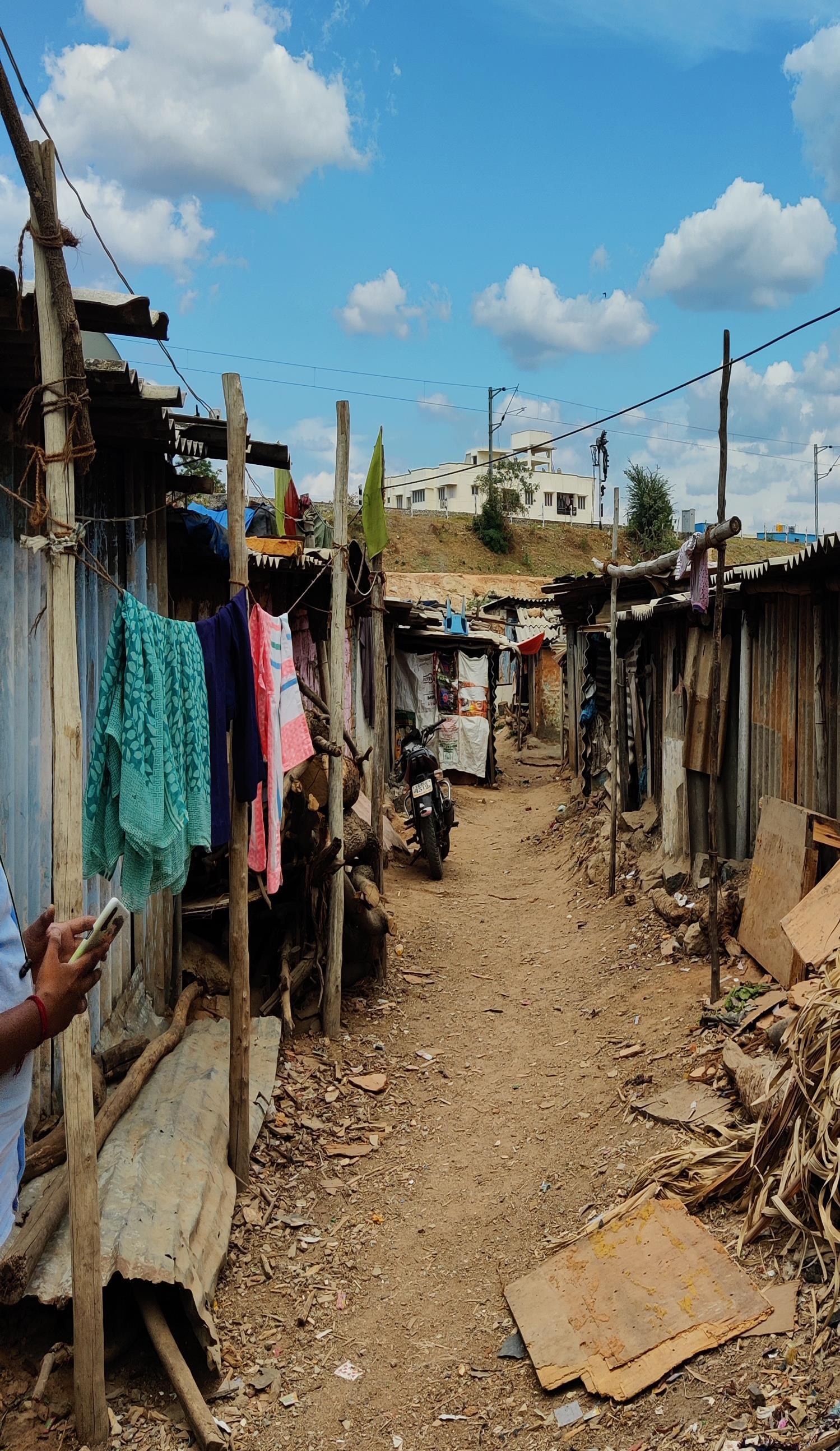Bengaluru
This newsletter series is brought out as a part of the Fair Urban Transition (FUT) Programme that promotes partnerships towards inclusive and fair climate action in cities across the world. Key to the programme is working with citizens and grassroots organizations to ensure that policies are developed fairly and inclusively and that they lead to a fairer transition. The partners of the FUT in Bengaluru are Purpose, Restless Development, and Mahila Housing Trust. This newsletter series communicates the activities, programmes, and interventions of the FUT in Bengaluru. We hope that the newsletters will serve to
City Resource Forum, Bengaluru
November 2022
initiate and disseminate policy dialogues around and at the intersection of climate change, informality, and urbanisation processes intrinsic to the city. We envisage that these dialogues will point to innovative ways and means to foster a just and fair urban transition in Namma Bengaluru!


In this first newsletter we share highlights of some of the key events and activities that happened in the last quarter and those planned for the coming one.
The CRF is anchored by Mahila Housing Sewa Trust (MHT) (supported by Integrated Design, INDÉ) and was conceived as a part of the FUT. The CRF is a coalition of diverse stakeholders working on and impacted by climate change, urbanisation, and informality and includes community members, technical experts, CBOs, and NGOs to ensure its inclusivity and sustenance. Going forward the CRF will include political representatives, city administrators as well as city level service providers. The CRF envisions to amplify the voices of urban poor, especially women, in the current context of climate change and urbanisation induced vulnerabilities, to nudge their inclusion in the city’s larger development goals by co creating advocacy tools and potential solutions.
CRF Meetings

The CRF met twice in the past two quarters. The introductory meeting of the CRF was held on 15th July 2022 at the Courtyard, Shanthi Nagar, Bengaluru and was attended by 23 members from 17 city organisations. What emerged from this initial meeting was the identification of synergies, possibilities of co-learning and collaboration, and the potential of the CRF to emerge as a meaningful force that can work for the city. The CRF met for the second time on the 28th of October 2022 at the Bangalore International Centre (BIC) and was attended by 23 members from 16 city organisations. The thematic focus of the second meeting was the need for an inclusive ward planning framework.
A City Climate Action Plan for Bengaluru
The Bangalore Municipal Corporation supported by the World Resources Institute (WRI) is preparing a City-scale Climate Action Plan. There is great interest from the BBMP to take the city climate action plan, being prepared by WRI, to the ward level. This is proposed through efforts like - sensitising Nodal officers on climate actions, seeking community’s inputs on the climate action plan etc. The CRF could potentially be a platform to garner data and experiences which can tie back to the city climate action plan.
Second Meeting of the City Resource Forum (CRF), Bengaluru
Shaping the CRF Identity
A name will have far-reaching impacts in conveying the core message of what the coalition stands for. Members present unanimously decided that the name should reflect not just a Kannada identity but also the inclusive spirit of the CRF. Through a polling exercise the name ‘Ellara Bengaluru’ (Everyone’s Bengaluru) was finalised
Chalking out a Structure
During the formative phase, the CRF was proposed to have a fluid structure with diverse partners. As the project progresses, it was proposed to evolve into a three-tiered structure with the following groups – the core group (group of members who will decide key tenets of the CRF), steering groups (groups of members tasked with driving the objectives and tasks of the CRF), and advisory group (group of members who can provide guidance and suggestions on the coalition’s vision, tasks, and way forward). The second CRF meeting deliberated further on the CRF structure. While a fluid and open structure with diverse partners was endorsed, some concerns as well as agreements emerged.
Agreements
Core Group: Roles & Composition

Paves the broad directions of the CRF necessitating the need for senior members with domain expertise, those with existing leverages with the government, and members who can anchor the role of raising finances for CRF functioning.
Foregrounds the realities of local governance (by including members like ward councillors, nodal officers, members of ward committees)
Acts as the CRF secretariat working on day-to-day functioning and administrative aspects

Convey the key messages of the CRF to the larger public (making media an important part of the core group).
Evolving a Ward Planning Framework
A potential Ward Planning Framework encompassing four mutually dependent phases was put forth for discussion.
EllaraBengaluru
Thematic Interests
Some of the thematic interests that emerged are listed below. It was agreed that the intrinsically linked themes could be clubbed into thematic clusters for collective engagement.
I Mobility I Public Open Spaces I
I Water & Sanitation I Livelihood I
I Solid Waste Management I
I Health & Nutrition I Housing I
I Built Environment I Energy I
Initial Ideas
The different phases of the framework addressed the following key questions:
Why is the phase required? What each phase intends to achieve? How it will be operationalised?
While different in approaches, many existing initiatives in the city are exploring pathways to build a ward planning framework. Some of these were discussed in the 2nd CRF meeting.

“Does the CRF require multiple groups?”
“Would a core group take away the flexibility of other CRF members? “
‘State of the Ward’ Framework
• Tool for rapid assessment of availability and dependability delivery of urban services and infrastructure
• Executed through ward level citizen audits to bring transparency and inclusiveness in budgeting and planning processes

The Framework has been tested in 4 wards in Bengaluru
‘

NammaWard,NammaDhwani’
Flourishing Wards = Flourishing Bengaluru

A ward level process for building collective capacities to
• Imagine a just and sustainable city
• Discern infrastructure choices that help achieve a just and sustainable city
• Navigate diverse, competing and even contradictory ideas and priorities
Tools of Engagement
Key Person Interviews
Focus Group Discussions

A space where a jury of residents of the ward deliberates and judge ideas of flourishing for their ward and for their city. Identify Priorities
Citizens’ Juries
Wicked Sprint
A space where key actors in the system with diverse roles and perspectives are brought together for 3-5 days to surface their wisdom on actualizing the priorities identified by citizens, build alignment among participants and, secure joint commitments for action
The Namma Ward, Namma Dhwani is being tested in 3 wards in Bengaluru
‘Ward Planning Toolkit’

As per the toolkit for developing a Gram Panchayat Development Plan, GPDP (as a part of Mission Antyodaya), an annual survey of the existing socio-economic infrastructure in gram panchayat must be benchmarked against official norms to be presented in gram sabhas to arrive at deficits. These deficits constitute the basis for preparing the GPDP. CIVIC has developed a Ward Planning Toolkit for urban areas along these lines.
Ward Planning in Bengaluru: Where are we stuck?
Excerpts of a Conversation with Kathyayini Chamaraj & T R Raghunandan


The 73rd and the 74th CAA ushered in the spirit of decentralisation in 1992. However, a reflection on how the amendments have fared shows that there is much work to be done in case of 74th CAA when compared to the 73rd CAA, especially in the case of citizen participation in local area planning. Local participation in urban areas falls far behind than that of rural areas. What do you think could be some of the reasons?
Yes, local participation in urban areas is in far worser shape than in rural areas. Some reasons could be
1. Urban citizens are ignorant about local governance. While some discussion and initiatives around urban participation is gaining momentum, a large portion of the urban populace still does not care and are ignorant.
2. In rural areas stakeholder interest is defined by place of residence. But this is difficult in an urban area because the place of work (where he or she spends more time) is usually different from the place of residence (where he or she may come back only at night).
3. There are many networked services in urban areas like water, drainage, roads etc. Planning for these can be done only to a limited extent by a ward committee. Because of the large prevalence of networked services in urban areas, defining stakeholder interest is much more difficult than in rural areas.
Local planning must be configured by being mindful of the fact that not all problems can be decentralised for solutions at the ward level. We need to have additional processes of citizen engagement to discuss and decide on large ticket projects and investments at the city level especially for networked services. . But I agree that we can of course start with the ward committees for decentralised planning in local sectors such as streetlights, solid waste management, stray dog menace, management of storm water drains, potholes amongst others. Another key issue is that urban areas lack the fiscal space to carry out proactive and participatory development activities.
On planning for networked services in the city, we (CIVIC) had suggested a city level urban forum where all stakeholders will be represented and should be consulted for city level planning initiatives.
The current mandated ward committee composition (as per Karnataka Municipal Corporations, KMC, Act, 2011 and the Bruhat Bengaluru Mahanagara Palike, BBMP, Act, 2020) does not align with the spirit of power devolution. As per the reforms put forth under the Jawaharlal Nehru National Urban Renewal Mission (JNNURM) in 2006, wards in a city were to be divided into Areas. The population/registered voters of these Areas would become members of respective Area Sabhas. Area Sabhas Representatives (elected by the Area Sabha) would then automatically be part of ward committees. The KMC Act was amended in 2011 to incorporate the provisions for such Area Sabhas However, as per the KMC Act, Area Sabha Representatives are nominated by the Corporation (on the recommendation of the ward councillor) and do not become automatic members of the Ward Committees. The BBMP Act, 2020 (which is an act that was prepared citing that the KMC Act was inadequate for governing Bengaluru) considers Area Sabha representatives as ‘invitees’ to ward committees but with no voting powers. In effect, ward committees would not represent members from all Areas of a ward.
Another issue is that ward committee members consist of only nominated members. The criteria for nomination is also insufficient to prepare a bottom-up plan because ground level representatives are missing in the ward committees. Nominated members should also include ASHA workers, Anganwadi workers, Cluster Resource Persons (CRP) and Block Resource Persons (BRP), and others who can even contribute to local data collection and maintenance. The ward committees also need to have nominated members with technical expertise like planners and engineers who can help in the preparation of a robust ward plan. But again, while nominated members can contribute to the preparation of ward plans, they alone cannot prepare an integrated, inclusive, and comprehensive plan for the ward since they don’t represent the entire ward. Pushing for a reform in ward committee composition could be one of the actions agendas for the CRF.
Adopted in 2017-18, the ‘Mission Antyodaya’ seeks to converge government interventions with Gram Panchayats in rural areas as the basic unit for planning. Preparing the Gram Panchayat Development Plan (GPDP) through a process of participatory planning is an important component of the Mission. Kathyayini, your recent article in Deccan Herald also talks about this. Do you think the GPDP framework can be replicated in an urban area for preparing a ward level plan? Raghunandan, based on your engagement with the mission and the GPDP exercise, what are the learnings from the GPDP? Can we replicate this framework in an urban area?


The GPDP toolkit under Mission Antyodaya is an excellent document that suggests a bottom-up process of planning by first assessing existing gaps in services to be identified through surveys, and then planning for addressing these gaps. If we look at the Karnataka Local Fund Authorities Fiscal Responsibility Act, 2003 it clearly says that the basic needs of the citizens should be prioritised. This is exactly what the GPDP is also attempting to do. The GPDP can very well be adapted to urban areas also but with certain changes. Things like the social infrastructure deficit surveys, which are done in rural areas, can easily be replicated in urban areas. Ward Development Plan should include surveys of social infrastructure deficits in housing, anganwadis, schools, primary health care centres as against the infrastructure standards mandated in policies, laws and national standards, such as the RTE Act, Indian Public Health Standards, etc. However, carrying out surveys to calculate human development index would be challenging given the higher migration levels in the urban. We need to explore ways in which we can capture this fluctuating citizen data in urban areas. While methods like compulsory registration of residents at the local level exist in other countries for local data collation, the feasibility of such an approach in India needs to be explored. However, capturing this data for smaller towns and cities may not be that big a challenge since they do not witness much migrant movement.

Do you think ward committees in its current composition is equipped to carry out a ward planning exercise (including data collection)?Kathyayini
As per the constitution, democratic decentralisation is a state subject and consequently the devolution of power and authority to panchayats and municipalities is left to the discretion of the states. Central initiatives like the GPDP often by-pass states to strengthen local governance bodies to further its agenda. In the process, they tend to marginalise the state governments while bringing in centralisation to planning. A second issue with the GPDP framework is that it uses the least performing states as a benchmark. So while it is also true that it did bring about a modicum of planning in underperforming states, it has also been criticised by better performing states such as Kerala where the GPDP has stifled many better performing local initiatives. While local level planning in urban areas needs to be pushed in a big way, I feel a prescriptive framework like that of the GPDP should not be the way to go about it. I feel frameworks for local area planning need to come from the state rather than from the centre simply because they understand and can respond to the context and regional specificities better.
The effort, time, and money that is required to carry out something like a household survey is enormous. In the current situation panchayat members in the absence of staff end up working as quasi executives. Under such circumstances, expecting them to carry out surveys and prepare plans without adequate financial and human resource capacity is not practically possible. In the end, without capacity, these plans usually end up being ghost written by the state-level bureaucracy. What is required as a first step is working out the finances needed for preparing a local plan. Participatory efforts can help in developing a local vision and a wish list of developments that the citizens require. But unless we match this wish list with the availability of finances, most of these would remain a wish list. When the finances which are allocated for plan preparation and implementation is way less than what is required as per the wish list, bureaucrats end up deciding which item in the wish list can be implemented and which cannot, essentially moving away from the essence of local level decision making.
The government also needs to be transparent about the corpus of finances that they plan to spend on a panchayat or municipality and its surrounding area, so that that planning at the local level becomes efficient. It is also essential that this corpus is untied (to whatever extent possible) so that local governments can decide on how to spend it. This was a key learning from many successful participatory models (like that of Kerala): the provision of untied finances (and advance information about the same) is the linchpin to successful democratic devolution and successful local area planning. In short, the state government and the union government need to tell them what is the fiscal envelope within which they must prepare and implement the local plan.




The GPDP toolkit mentions that the funds spent by the higher tiers like District Panchayat and Intermediate Panchayat in the Panchayat should mandatorily be part of the Resource Envelope of GP. After finalizing the elements of the resource envelope, the State is to communicate in writing, well ahead of initiation of the planning process, the resources available to each GP. If this is not actually happening, then the GPs will have to be empowered with this knowledge so that they can assert themselves.
What could be the first step towards making ward planning a reality in Bengaluru?
A budget envelope must be given to the ward committees. A certain portion of the BBMP budget must be earmarked as untied funds for the ward. This could be the catalyst to kick start participatory ward planning.
I agree with Mr. Raghunandan on providing untied funding to wards. Apart from that I feel a database of citizens in the ward is critical to plan for the ward. While I agree that currently the capacity to carry out surveys and maintain local database is limited, a team of ASHA workers, Anganwadi workers, Cluster Resource Persons (CRP) and Block Resource Persons (BRP) and others should be set up for carrying out surveys and maintaining a common ward level database. There should also be a mechanism to keep this database updated. This database can then be used by all government departments to avoid duplication of efforts. Currently there is no coherence between databases of multiple departments. We should also explore how existing databases like the ‘Kutumba’ data (a digitised comprehensive database of over one crore families of Karnataka, covering more than 5.5 crore people by the Department of Personnel & Administrative Reforms (DPAR) of Karnataka) can be made available at the ward level. This digitised data will generate the lists of eligible beneficiaries for various government schemes without the persons needing to even apply for them.
Kathyayini is the Executive Trustee of CIVIC Bangalore, which works on issues of urban governance with a rights-based approach. She has worked extensively with Government of Karnataka on child labour and primary education.

TRRaghunandan
Raghunandan is a consultant in decentralization, anticorruption and heritage conservation. Formerly in the Indian Administrative Service, he quit the IAS in 2010 and now works on strengthening local democracy and local governments and working on anti-corruption.

Emerging Agendas for the CRF
Advocate to plug gaps in local data
Lack of reliable data for local level planning emerged as a key gap impeding ward planning efforts. The works carried out by Socratus Foundation and Sensing Local, where gathering local and grounded socio-economic and spatial data are important components, become key and relevant in plugging this data gap. The necessity of making existing data available at the ward level and benefits of having a single ward database that can be used by all government departments could be an advocacy agenda for the CRF.
Map citizen engagement platforms
Mapping platforms other than ward committees (like Slum Sanghatanes) emerged as an initial action agenda to prepare an inclusive ward level planning framework. Such platforms in addition to local colleges and educational institutions could also be leveraged to collect the much needed grounded socio-economic and spatial ward data.

Advocate for reforms in ward planning
Pushing for reforms in ward planning was suggested as a possible advocacy agenda that the CRF can take up. This included reforms in composition of ward committees, a comprehensive framework for carrying out ward planning, integration of local area plans with larger city level planning frameworks, and allocating untied finances for ward planning also emerged as a potential tool for pushing local planning.
Announcements
3rd Meeting of the CRF
The third meeting of the CRF is tentatively planned to be around mid-January. While the agenda of developing a ward planning framework will continue, we welcome suggestions on a thematic focus for the next CRF meeting.
